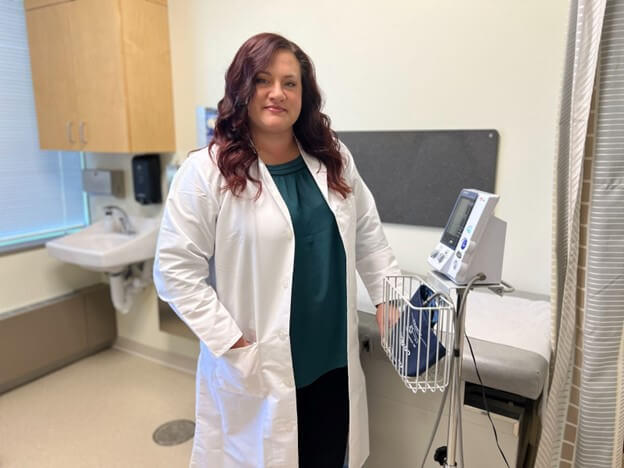
Today we welcome a guest post from The Hormel Institute, who are active members of the Austin Area Chamber of Commerce.
Our health has a major impact on our quality of life as humans—and it’s a no-brainer that most of us would prefer to stay as healthy as possible. To accomplish that, it helps to have recommendations backed by scientific evidence.
That’s where clinical research comes in.
Clinical research helps us understand what keeps humans healthy—and what factors may contribute to illness or disease. Findings from clinical research can help people make more informed decisions to protect their health and lead to safe, effective treatment or preventative measures when illness or injury arise.
The Hormel Institute currently has three clinical studies underway. Here’s a look at what each one involves—and why including rural Minnesota in clinical research matters.
Current clinical studies at The Hormel Institute
At present, the clinical research underway at The Hormel Institute is primarily focused on how certain environmental and genetic factors can influence cancer risk.
Two Drink Study
Our first study at the Institute, called the “Two Drink Study,” began in January 2022. This study is in partnership with the Tobacco Research Programs at the University of Minnesota (UMN). Co-primary investigators (PIs) for this study are Dr. Dorothy Hatsukami and Dr. Stephen Hecht.
The Two Drink Study’s hypothesis is that the consumption of a certain vegetable drink is a rich source of a cancer chemopreventive agent, and it will enhance the detoxification of multiple environmental toxicants and carcinogens. In this blinded study, participants consume two different drinks to test the hypothesis.
If the hypothesis is found to be correct, this could lead to the production of an affordable, nourishing dietary component that could help prevent certain types of cancer.

10,000 Families Study
The Hormel Institute has also partnered with the 10,000 Families Study. The study intends to follow Minnesota families over time to understand how various factors like genetics, lifestyle, and the environment can influence human health and risks for particular illnesses.
The study will involve analyzing the prevalence and development of disease(s) among participants to identify risk factors that play either protective or harmful roles across generations—as well as how differences may display themselves within families and across communities.


The Smoking and Alcohol Study
The third ongoing study here at the Hormel Institute is the Smoking and Alcohol Study. It is also in collaboration with The Tobacco Research Programs, and Dr. Hecht is also its PI.
As you might infer from the title, this study is examining the impact of cigarette smoking and alcohol consumption on the development of DNA damage in the oral cavity. Ultimately, The Smoking and Alcohol Study seeks to identify DNA damage that could increase the risk for cancers of the head and neck.
If you meet the study’s eligibility criteria, a representative from The Hormel Institute will contact you to set up an appointment. At the appointment, you’ll be able to review consent forms and learn more about what the study entails so you can decide whether or not you want to participate.
What are the potential benefits of this clinical research?
If The Two Drink Study is proven effective, it could show that eating a certain vegetable can remove toxins from our bodies that would otherwise increase our cancer risk. These results could then influence doctors to recommend a diet rich in these vegetable types to reduce risks for certain cancers.
The 10,000 Families Study and The Smoking and Alcohol Study are both looking for patterns that could lead to the identification of certain health and genetic risk factors associated with cancer. These studies could potentially lead to identifying people’s cancer risks before it ever occurs, or during earlier stages of cancer, when prevention and treatment can prove more effective.
Why including rural Minnesota matters
To benefit as many people as possible, clinical research must account for the ways that different populations’ health will be impacted in different ways, including by their local environments. Rural Minnesotans are often exposed to different environments than those living in urban areas, which can potentially lead to very different results.
“Most clinical studies are conducted in large cities where the organization doing the study is located. This usually excludes people in rural communities due to time and transportation issues,” said Emily Heath, Clinical Research and Outreach Nurse at The Hormel Institute.
“Having the Institute as a satellite site for studies originating at the UMN and starting our own studies makes sure that people in rural Minnesota are represented in research.”
“To be able to have treatments and information that can benefit everyone, we need to be able to study all groups of people. It’s one of the best ways that people can be represented in healthcare.”
How do people get involved in clinical studies at The Hormel Institute?
Information about The Hormel Institute’s current clinical studies are available on the “Research Studies” page of our website: https://www.hi.umn.edu/community/clinical-trial/.
When studies are open to new participants, you can also find The Hormel Institute’s advertisements in a variety of places: on KAUS Radio, flyers throughout the community, on Facebook, during community events, and so on.
If you find a clinical study you’d like to participate in, getting involved is as easy as clicking the links provided on our website and filling out a screening questionnaire.
Only the beginning
To quote Emily Heath, “This is just the beginning for us.”
Here at The Hormel Institute, we understand the value of holding clinical studies in rural Minnesota, and we plan to continue to expand our research efforts in this area. We are working with The Hormel Institute scientists to launch more studies soon, and we’re hoping to recruit participants for a new study in October—which would be the first internally driven study at The Hormel Institute.
For now, we simply want to highlight that we do have clinical research opportunities—right here and now. We encourage those in the area who are interested to participate.
Keep checking our website, looking for our advertisements, and spread the word! We are more than willing to come to local group meetings or workplaces to talk about our studies and invite people to learn more and get involved.
For more information, you can visit the Research Studies page on our website: https://www.hi.umn.edu/community/clinical-trial/.
FAQ
Clinical trials vs. clinical studies: What’s the difference?
Clinical trials and clinical studies are both terms that can come up in conversations about clinical research. While they might seem similar on the surface, they do have some important distinctions.
- Clinical trials involve some sort of intervention—such as the use of medicine or surgery—to study its safety and effectiveness.
- Clinical studies is a broader term that encompasses clinical trials. There are different types of clinical studies: some may involve an intervention (i.e., a clinical trial), while others will not involve an intervention and instead monitor people and their health in an unaltered setting (an observational study).


Information about The Hormel Institute’s current clinical studies are available on the “Research Studies” page of our website: https://www.hi.umn.edu/community/clinical-trial/.

